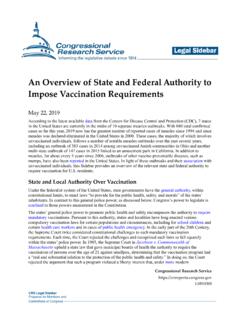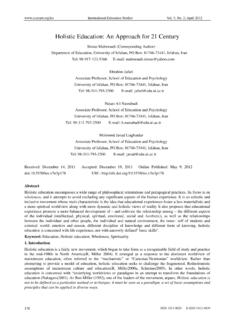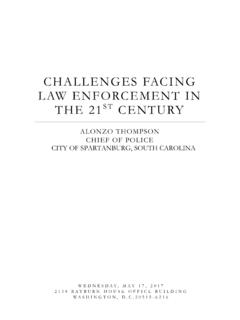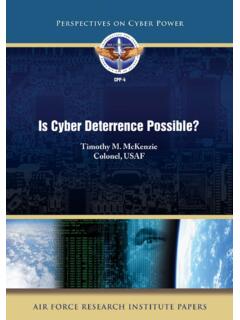Transcription of Teaching Practice in the 21st Century: Emerging Trends ...
1 Teaching Practice in the 21st century : Emerging Trends , Challenges and Opportunities Cecelia Jansen1,*, Petro van der Merwe2 1 Department of Educational Leadership and Management, College of Education, Unisa 2 Department of Psychology, College of Human Sciences, Unisa Copyright 2015 Horizon Research Publishing All rights reserved. Abstract Digital technology for Teaching Practice students means the ability of student teachers to use digital artefacts as integral part of their pedagogical content knowledge. Student teachers need to be also aware of what implications this has for Teaching and learning strategies plus the building aspects in the lesson presentation. A new approach to Teaching Practice , calibrated for the 21st century , requires teachers to be willing to assist the student teachers in this regard.
2 The Teaching Practice period is meant to expose student teachers to the most sobering technological frontier in history because they inherit a complex set of global dilemmas and this emphasise the rational of this study. The proposed study aims to prepare Teaching Practice students for the classrooms of the future. Teachers often expressed their lack of confidence in their digital technology skills and this can implicitly affect their attitudes towards the use of digital technology in their Teaching . Therefore, the presenters argue that, the Teaching Practice student should be empowered in the fast-paced digital environment of the current millennium generation. Teachers often do not expect learners to be sharing knowledge through connections.
3 This is a key aspect of learning in the digital age within a connectivist learning theory. The empirical research has been conducted in an interpretive qualitative paradigm underpinned by a complexity theory conceptual framework. Convenience sampling has been used in this study. One teacher from each of the three secondary schools in Gauteng has been selected to participate. This study has challenged the participating teachers to reflect on their own Teaching praxis when using digital technology as an integrated part of their pedagogical content knowledge. One of the outputs of this research study is a model for teachers to use as an example for training the Teaching Practice students. This model can also be a source of information for digital technology literacy education.
4 The intention is to guide Teaching Practice students to develop their own programmes for digital technology literacy to meet the Teaching demands for the 21st century . Keywords Digital Technology Literacy Education, Teaching Practice , Millennium Generation, Digital Artefacts for Pedagogical Content Knowledge 1. Digital Technology Literacy: A New Approach to Teaching Practice Introduction The world children grow up in today is increasingly multimodal due to ever new technologies Okeke, Van Wyk & Phasha [1] researchers argue that the these technologies shape what it means to be literate in the 21st century as it continues to impact on how information is communicated and exchanged. This naturally determines the skills Teaching Practice students need and raises the question whether the current pedagogy curriculum for Teaching Practice recognises these all-important skills.
5 Marais and Meier [2] assert that the term Teaching Practice represents the range of experiences to which student teachers are exposed when they work in classrooms and schools. Therefore the relationship between classroom teachers (mentors) and Teaching Practice students are important Louw & du Toit [3]. The researchers debate that classroom teachers have to give the Teaching Practice students valuable advice and share their skills and experience. However, some teachers fear change, and so they hold on to traditional Teaching Peterson [4]. Some teachers believe there is no urgent need for a change to a new educational model and they will even resist change at all cost Codrington & Grant-Marshall [5]. Teachers might think they do not need to change, as they succeeded without the digital tools.
6 This can cause a digital divide between Teaching Practice students and teachers. Teachers may not feel comfortable with the digital tools, which would create a gap between them and the Teaching Practice students who are more comfortable with digital tools. Godrington and Grant-Marshall [5 p 146] describe it as follows: It has required a HUGE paradigm shift, which only the best teachers have succeeded in making successful. Some teachers use of technology is sometimes limited and they are not interested in social media tools. While Teaching Practice students know that technology is a part of today's world and thrive on technology and gadgets. Although, many Teaching Practice students may not feel an affinity for digital technologies and need constant guidance from classroom teachers, for example preparing a lesson in a way where technology can be integrated in a meaningful and functional way.
7 The researchers argue that the effective development of digital technology literacy in Teaching Practice training should be seen as a process of professional, inter-professional and curricular development as much as teacher training and development. Williams and Wavell [6] state that providing teachers with a model for the process of digital technology literacy Teaching may not be as helpful as allowing them to discuss, collaborate and form consensus about the subject at Teaching Practice level. One benefit of the model proposed in this article is that it acknowledges that sound digital technology learning entails revisiting a concept repeatedly over a period of time in order for Teaching Practice students to learn and fully understand the concept of digital artefacts as an integrated part of their pedagogical content knowledge.
8 The curriculum should, according to the researchers, revisit basic ideas repeatedly and build on them, and therefore the teacher has to act as a facilitator to guide and navigate the Teaching Practice student through a process that enables the Teaching Practice student to use critical thinking in the context of new technology. With the deictic changes in information, communication, and technology, the role of teachers is changing and becoming more important in a way that teachers have to think about Teaching Practice students who are eager about technology use Leu, Kinzer, Coiro, & Cammak [7]. The main aim of this conceptual article is to explore the way teachers; mainly those who come from low technology areas can change their methodology and content to fit with the digital frame in Teaching Practice .
9 The proposed model includes a dimension for teachers to once they understand the areas of changes, teachers will encourage Teaching Practice students to be more creative than they already are with regard to digital technology literacy Teaching skills. This study reminds us that digital technology literacy is multidimensional. The nature and extent of the digital technology literacy an individual needs and develops largely depend on the purposes they use new technology for in the first place. The researchers argue that different social groups may also require different forms of digital technology literacy, depending on their motivations for new technology use and therefore teachers need to guard against a reductive or mechanistic approach when assessing the levels of digital technology literacy in Teaching Practice students.
10 In relation to the Teaching of new technology literacy, the researchers use the all-encompassing term digital media literacy . A general definition of this term is that it incorporates the skills, knowledge, creativity and attitudes everyone needs when using digital media for learning and mastering the knowledge society Newman [8]. This is, however, a general definition, which only to a certain extent manages to encompass digital media literacy in school settings. Therefore, the researchers have found it necessary to include a narrower definition that more directly focuses on Teaching Practice teachers and digital media literacy in school settings: Digital media literacy for in-service teachers is the ability to use digital artefacts as an integrated part of their pedagogical content knowledge and be aware of what implications this has for Teaching , learning strategies and building aspects.













